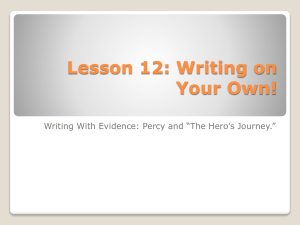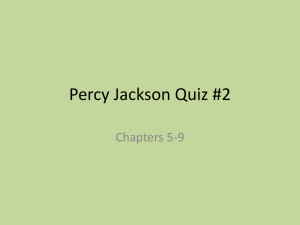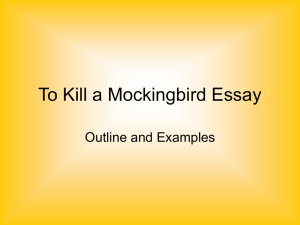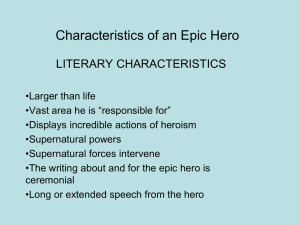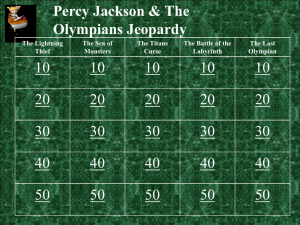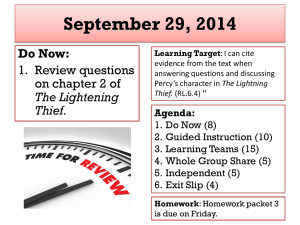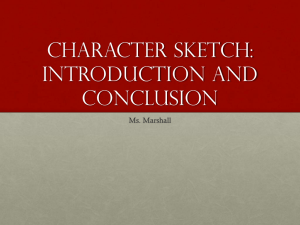Examples - Woodcliff Lake
advertisement
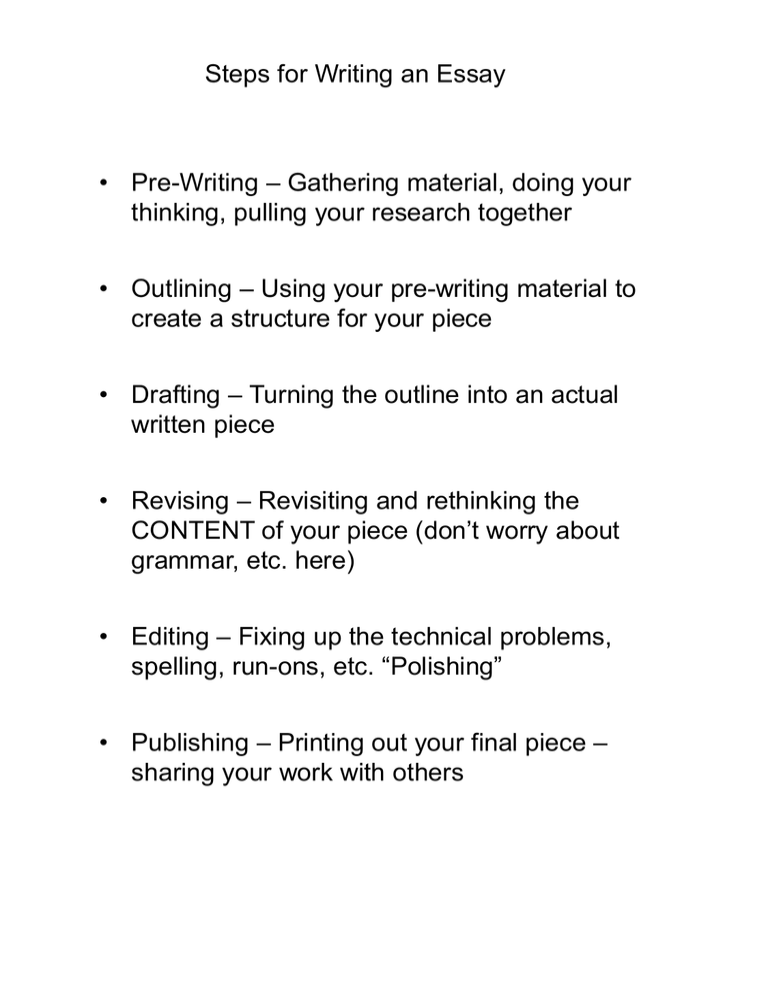
Steps for Writing an Essay • Pre-Writing – Gathering material, doing your thinking, pulling your research together • Outlining – Using your pre-writing material to create a structure for your piece • Drafting – Turning the outline into an actual written piece • Revising – Revisiting and rethinking the CONTENT of your piece (don’t worry about grammar, etc. here) • Editing – Fixing up the technical problems, spelling, run-ons, etc. “Polishing” • Publishing – Printing out your final piece – sharing your work with others The Plot Diagram/Sequence Exposition – The main character is introduced, we see him/her in the “before” stage – we learn about what regular life is like for that character “before” the events of the book start to unfold. Rising Action – The problem is introduced and the events of the book start to unfold. Tension builds and things start to get worse and worse for the main character. There may be small victories scattered in, but the problems keep coming. Climax – The shortest moment in the book – It is often just a quick moment. It is the point of greatest tension when things have reached a crescendo and are as bad as they are going to get. The moment the tension breaks the story moves into the falling action. Falling Action – The tension is broken and all the loose ends start getting tidied up. Resolution – We see the character in his/her “After” state. He/She has changed, grown, and learned new things. We see how this will now affect the character’s life. The Hero’s Journey In almost every young adult novel, the hero or main character goes on a journey of change. The journey is not always an actual journey – sometimes it is an emotional journey. At the end of the story, the hero has changed because of whatever happened to him/her, and has learned something new about him/herself. Each hero’s journey has 5 stages. These stages are different from the ones you see in a plot diagram. Together with the 5 stages of plot, the 5 stages of a hero’s journey make a very complete picture of a novel. The Hero’s Journey The 5 stages are: 1.Departure – The hero is called to adventure – most of the time he/she does not want to go. 2.Initiation – The hero crosses some kind of a threshold and steps into a new world where he/she must learn many new things. Often during the initiation the hero will meet his/her sage teacher and his/her special weapon will be revealed, if not to the character then to the reader. The weapon can be an object or an ability – The hero is not yet very good at using it. Usually during the initiation the hero is also introduced to or learns about the villain. The villain can be a person (human or otherwise), an illness, or some kind of inner struggle (I know I’m different but I don’t want to tell anyone else about it.). 1.Road of Trials – The Road of Trials takes up the majority of the book. On this road the hero faces many obstacles and has to overcome each one. As he/she overcomes an obstacle, he/she learns something new and moves closer to coming into his/her full hero’s power. Often the hero is accompanied on his/her road of trials by his/her companion/sidekicks. The Hero’s Journey 4. Innermost Cave – This is the hero’s lowest point – although the cave represents the hero’s darkened mood, an author will put the character in an actual dark place like a basement or a forest. Inside the Innermost Cave, the hero must struggle with his greatest fear or weakness and overcome it. When the hero has overcome his/her greatest struggle, he/she is ready to emerge from the Innermost Cave. At this point, he/she is in his/her full hero’s power and is capable of wielding the special weapon with mastery. He/she will quickly move to the climax of the story where he/she will face the villain. 4. Return and Reintegration - The hero has overcome the final obstacle during the climax and the final confrontation with the villain. He now returns to his life, sometimes the old life, sometimes a new one, but is living it as a changed person and in his full hero’s power. In your writing journal: Chart the hero’s journey and plot sequence for The Lightning Thief. ***Hint – The initiation and departure are reversed! The Important Parts of an Essay • An essay can be thought of in 3 parts: • Say what you’re going to say • Say it • Say what you said • Lead • Thesis Statement • Claim • Avenues • Body Paragraphs • Introduce the Example • Example • 3-part analysis • Conclusion • Transitions The Thesis Statement A thesis statement is the heart of your essay. It is the main point that you want to make. Everything you write has to be written with the thesis statement in mind. A thesis statement is thoughtful and insightful. It is general, but not boring or obvious. Sample thesis statements: Not so good: In The Lightning Thief by Rick Riordan, Percy Jackson, the main character, changes in many ways. Better: In The Lightning Thief by Rick Riordan, Percy Jackson, the main character, learns a lot about who he really is. Even better: In The Lightning Thief by Rick Riorday, Percy Jackson, the main character transforms from a troubled kid into a confident hero. In your Writing Journal: Create a before and after chart with 6 -7 SPECIFIC examples from the text of how Percy changes. Types of Literary Devices FORESHADOWING – Hints given throughout the story about what is going to happen later on. FIGURATIVE LANGUAGE – There are several types of figurative language that help to create an emotional connection with the reader. •Hyperbole – Exaggeration to emphasize a point. Example: His legs were so long he had to drive from the back seat. •Metaphor/Simile – comparison used to create emphasis or description. Example: Her hair was a waterfall of silk that cascaded down her back. •Personification – giving something non-human human qualities. Example: The wind brushed past and whispered in my ear. •Imagery – Painting a VISUAL picture in the mind of the reader by being very descriptive. Imagery can contain other types of figurative language. In your writing journal – Find 2 examples of each type of literary device. List the page number, the emotion attached to the example, and discuss how it shows Percy’s change. (Hint – You’ll have to find one that shows “before” and one that shows “after”. Thesis Claim: The way Percy changes in the book is emphasized by theme and figurative language. In your notebook: Figurative Language: Hyperbole - Example: On page 118 – “My shield was the size of an NBA backboard with a big caduceus in the middle. It weighed about a million pounds. I could have snowboarded on it fine, but I hoped nobody seriously expected me to run fast.” This shows that Percy is still on the brink of change, but not there yet. The emotion that is conveyed is one of feeling overwhelmed and anxious. He feels so small and unprepared for battle, even though it’s just a game. We can see that even though he sounds sarcastic, underneath he’s scared about fitting in, and still has no confidence in himself or his abilities. Thesis Claim: The way Percy changes in the book is emphasized by theme and figurative language. In your journal: P. 329 “I was holding back the tide by force of will, but tension was building like carbonation behind a cork.” Emotion: Analysis: (Write a paragraph discussing how the figurative language above shows Percy’s change.) Common Themes in Literature Community/Isolation Power over others/Power over self Curiosity/Denial Inner Truth Coming of Age Power of Love In your writing journal – choose 2 of these themes and discuss how they apply to The Lightning Thief. See the example on the next page. Thesis Claim: The way Percy changes in the book is emphasized by theme and figurative language. In your journal: Pick 2 themes, find examples of them in the book, write a short paragraph tying the example to the thesis statement. Example: Theme: Community vs. Isolation On page 127 Percy talks about how miserable he is being alone in the Poseidon cabin. This emphasizes his isolation and shows that he has not changed yet, but he is about to. He has been isolated by his status as a hero, but he hasn’t earned the title yet. He has yet to find out that the isolation is all in his mind and that the power of community will ultimately be what helps him to complete his quest. In The Lightning Thief by Rick Riordan, Percy Jackson, the main character transforms from a troubled kid into a confident hero and this change can be seen in the book’s theme Figurative language. The theme of community vs. isolation truly shows how Percy changes. The Sandwich Strategy The sandwich strategy is used with the examples in the body paragraphs. • Introduce the example • Example • Explain the example Examples: Before: The theme of Coming of Age shows how Percy changes. One example of this is when Percy fights Aunty Em. This shows that Percy hasn’t changed yet. After: The theme of Coming of Age shows how Percy changes. At the beginning of the book, Percy is less mature and is not in his full hero’s power. An example of this is when Percy fights Aunty Em. 1This scene shows that Percy hasn’t changed yet because he fails to see her trap and then needs the help of Annabeth and Grover to get out of it. 2Percy’s immaturity causes him to ignore the red flags and Grover’s worry and to concentrate only on the food. 3 He is not yet wise enough to see the obvious danger he is in, and he is therefore too slow to react. A Good Analysis The analysis piece in an essay is the most important part because it ties your examples to the thesis. This part of the essay is the “bottom bread” of the sandwich – the part where you explain your example. A good analysis has these qualities: •Ties the example to the thesis by explaining why •Is specific rather than general •Shows insight Examples: Not So Good: One example is when Percy fights Crusty. This scene shows that he has changed. Better: One example is when Percy fights Crusty. This scene shows that he has changed because he has become a better and more confident fighter. Even Better: We can see how far Percy has come on his journey as a hero when he fights Crusty. He handles this monster with confidence, using a combination of fighting skills and cleverness to stay in control at all times. When compared to the fight with Aunty Em, in which he was confused and inept, the reader can see how much of a hero Percy has truly become. This battle is the outcome of all the practice he has had fighting other monsters and it is clear that he has learned a great deal. 3 Points of Analysis The bottom “bread” of your sandwich should be the thickest of all. It ties your example to your topic statement and to your thesis. In order to analyze your example in depth you need to use at least 3 points of analysis Prompts to consider using in the analysis section: 1.When compared to 2.In contrast to 3.If ______________ then ______________ 4.This is the outcome of ___________________ 5.Other possible outcomes of ________ might have been ________________ 6._________________occurred because__________ 7.An explanation of ________is__________________ 8.The way in which _________ occurs or is accomplished is 9._____________ is like ______________ because (metaphor) We can see how far Percy has come on his journey as a hero when he fights Crusty. . 8He handles Crusty with confidence, using a combination of fighting skills and cleverness to stay in control at all times. 1When compared to the fight with Aunty Em, in which he was confused and inept, the reader can see how much of a hero Percy has truly become. 4This battle is the outcome of all the practice he has had fighting other monsters and it is clear that he has learned a great deal. In your outline: Use 3 points of analysis with one theme example and one figurative language example. Essay Lead • Hooks the reader • Relates to the topic, but often more indirectly • In a literary essay the lead can give the reader an overview of the story • Should not be too short that it feels abrupt • Should not be too long that it seems to take forever to get to the point A Good Lead in a Literary Essay Should: • Give the name and author of the book • Give the basics of the story – setting, time place, etc. • Broadly outline the main problem of the story • Mention the main character and possibly one or two others • Give the reader enough information to understand the analysis that will follow, but don’t give too much away. Revision Strategies • Build Transitions • Use Elaboration Strategies • Use Strong Verbs • Check Sentence Structures • Read Alouds Transitions • 3 Parts to a transition • Refer back to what you just talked about • Refer forward to what you’re going to talk about • Linking idea • Transitions can be used between sentences as the first step in revision • Go through each paragraph two sentences at a time and build a transition sentence between each pair. • Re-read your paragraphs aloud. • Add anything that feels unsaid • Delete where you feel like you’ve overdone it Elaboration Strategies • Explain Why • Explain Why Not • Explain How • Explain the Details • Define • Give an example Using Powerful Verbs and Adjectives (And Dropping Unnecessary Adverbs!) Some verbs are better than others. When you revise: •Go through your draft and underline all the verbs. •Give them the “vanilla” test. •If they are too vanilla, or if you are using adverbs to spice them up, use a thesaurus to find a more “spicy” verb. •Avoid using the same “spicy” verb twice. Examples: Not so good: When the character goes to talk to his father, he feels completely and totally angry. Better When the character confronts his father, he is enraged. Not so good: The character was using a good strategy, which is how the reader can clearly and easily see his change. Better: The character was using a clever strategy, which is how the reader can identify his transformation. Fine-Tuning Sentences for Better Flow Sentence structure affects the way the language of your piece flows. • • • • Read through the piece ALOUD to yourself Read it through ALOUD to someone else Have someone else read it ALOUD to you Listen for: • Short, choppy sentences • Repetitious words or ideas • Combine short sentences • Delete or reword repetitious ideas or words Examples: Not So Good: Percy made Nancy Bobofit fall in the fountain. He made her fall in the fountain because he was immature and he didn’t know about his power. Better: Percy caused Nancy Bobofit’s fall into the fountain because he was immature and didn’t yet know about his power. Not So Good: The fight with Ares was the climax of the story. Percy used the ocean to defeat Ares. Percy was in his full power. Better: The fight with Ares was the climax of the story. Percy was in his full power and was able to use his special weapon, the ocean, to defeat the god of war. Editing Basics Verbs: Agreement – Subjects and verbs. Tense – Check each verb – are they all in the same tense? Variety – Are you using the same verbs over and over again? Person – Does it switch anywhere from you to I, from I to they, from you to they or he/she? Have you taken “I” out of it, as in “I think”… Word Variety – Are you using the same word over and over again? Sentence Structure – Are your sentences varied and not all the same? Spelling – Check for words the spell checker won’t pick up and incorrect duplicates ie. Aloud/Allowed Capitalization – Beginning of sentences, and proper nouns Sentences – Check for run-ons and fragments. Strategy: •Read your piece backwards. This will help you find spelling and technical errors. •Read it aloud to a partner – have the partner read it aloud to you. Read-Alouds Work with 1 or 2 other people. Focus on one writer at a time. First Writer reads his/her writing aloud while other writer(s) listen. Whenever something in the writing comes up that needs to be addressed, whoever hears it comments and the writer makes a note to change it. Do NOT focus on grammar and spelling – look past it and think only about the CONTENT! When the writer is finished reading his/her work aloud, the other writer takes it and reads it aloud for a SECOND time. Whenever something comes up in the writing, stop and let the writer make a note. Repeat for the other writer(s)

